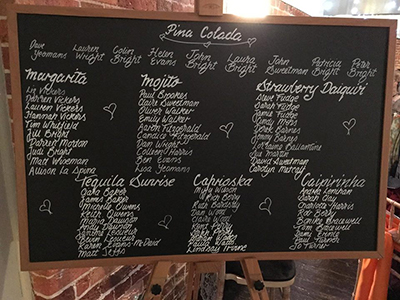
I did not use a ruler or anything to draw the individual letters, I more or less carved out the letterforms, being able to add and remove weight and tweak them until I was satisfied. This creates a nice texture and is very forgiving if your lines are not that perfect. Working with chalk is pretty easy because it never evenly covers the blackboard’s surface.

It got denser than I wanted it to be, but I’ll be able to live with it Adding some weight to the sketched out “Tomate” with a sharpened chalk The finished left column. After that, I added more weight and fine-tuned each letter and in the end the whole word. Before writing one “perfect” letter I drew the skeleton of every word very lightly to make sure it fits within the given space. Unfortunately, it always broke at a certain size and I had to take a new one. I sharpened my chalks to easily draw details. Start in a direction where you won’t smudge anything already on the board (if you’re right-handed it will be from left to right). Things won’t be that exact on the board in comparison to paper and it’s always easier with more leeway. My tip for you:Īdd a little more space than you think you need. This took pretty long for my 2 × 2 meters sized board (around two hours) and I did a lot of corrections before I was satisfied. I sketched out three columns and every baseline, measuring things by visual judgment, but you can, of course, use a tape rule. This is a very important part because it is the scaffolding of everything you letter, so give it some time. With a mason’s level I outlined the layout and a baseline gridĪfter that, I took a mason’s level to draw the grid of my layout. This might take some time but it will definitely improve the end result.

If you are new to lettering or don’t have a lot of experience yet, I suggest you make precise sketches on paper. I didn’t dig much into the details, because I wanted to fine-tune my lettering on the board and not on paper. What I focused on were the composition, proper hierarchies and what styles of lettering there should be. In my case, I was satisfied with a rough draft of the layout in my sketchbook. I changed some words on the board later because it was less space than I expected. My fast sketch how the menu should look like. Although you can always erase stuff, it still takes a lot of time and effort to fix the overall layout later. If you don’t have a lot of experience (and even then) it’s a bad idea to start on the board directly and improvise, especially if you get lost in details easily and forget about the overall design (like I do). Before: What the menu looked like at Cinema Paradiso Baden Sketching things outīefore you draw on your chalkboard you need some kind of plan or sketch how it should look like. Of course, you should have a clean and dry surface to write on – remember the times you were at school and had to reluctantly wipe the blackboard and do it more careful this time.

A sponge and a cloth for correcting and fine-tuning things.Simple chalk – I got it from the office supplies store near me.You might be surprised to see how basic this list of tools is, but there is nothing you’ll miss.

Things you’ll need for chalkboard lettering I’ll tell you about the tools I used, how I sketched things out, my way of doing the lettering, what I learned from it and what I would do differently next time. In this article, I want to share you my experiences with doing lettering on a chalkboard for the first time. What a great chance to try out my lettering on a new medium – a 2 by 2 meters big chalkboard. Luckily the opportunity came up to rewrite the menu at Cinema Paradiso Baden, my beloved local cinema. I frequently write and draw, but I never did it on a big board or anywhere similar. Ever since going to design school I’ve been addicted to handwriting, lettering, calligraphy – basically everything type.


 0 kommentar(er)
0 kommentar(er)
